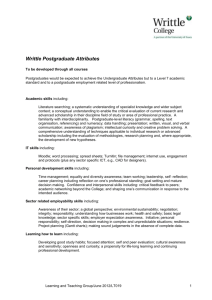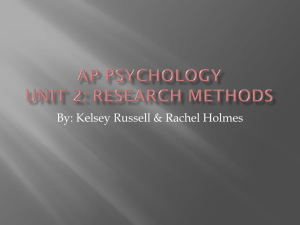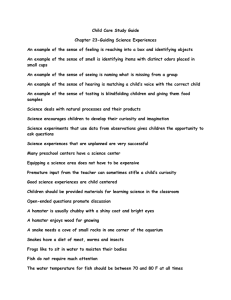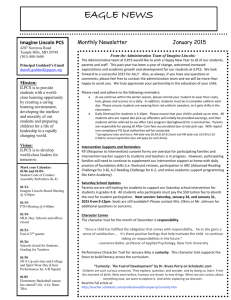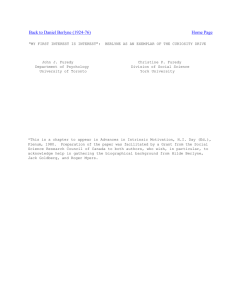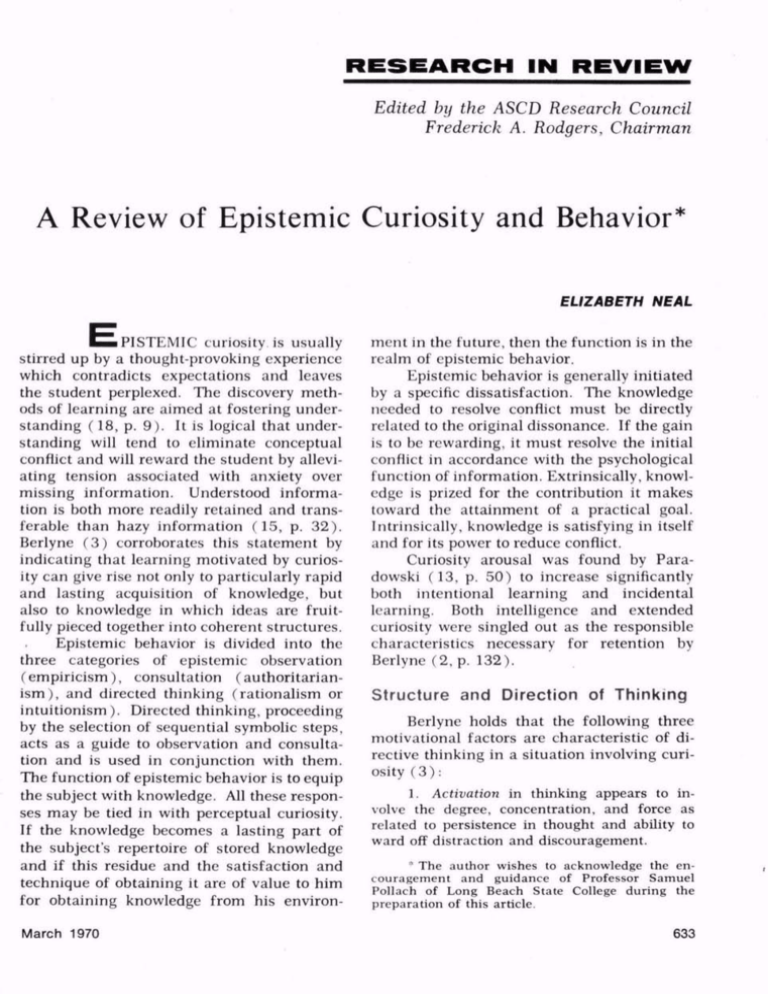
RESEARCH IN REVIEW
Edited by the ASCD Research Council
Frederick A. Rodgers, Chairman
A Review of Epistemic Curiosity and Behavior 3
ELIZABETH NEAL
KSiPISTEMIC curiosity is usually
stirred up by a thought-provoking experience
which contradicts expectations and leaves
the student perplexed. The discovery meth
ods of learning are aimed at fostering under
standing (18, p. 9). It is logical that under
standing will tend to eliminate conceptual
conflict and will reward the student by allevi
ating tension associated with anxiety over
missing information. Understood informa
tion is both more readily retained and trans
ferable than hazy information (15, p. 32).
Berlyne (3) corroborates this statement by
indicating that learning motivated by curios
ity can give rise not only to particularly rapid
and lasting acquisition of knowledge, but
also to knowledge in which ideas are fruit
fully pieced together into coherent structures.
Epistemic behavior is divided into the
three categories of epistemic observation
(empiricism), consultation (authoritarianism), and directed thinking (rationalism or
intuitionism). Directed thinking, proceeding
by the selection of sequential symbolic steps,
acts as a guide to observation and consulta
tion and is used in conjunction with them.
The function of epistemic behavior is to equip
the subject with knowledge. All these respon
ses may be tied in with perceptual curiosity.
If the knowledge becomes a lasting part of
the subject's repertoire of stored knowledge
and if this residue and the satisfaction and
technique of obtaining it are of value to him
for obtaining knowledge from his environ
March 1970
ment in the future, then the function is in the
realm of epistemic behavior.
Epistemic behavior is generally initiated
by a specific dissatisfaction. The knowledge
needed to resolve conflict must be directly
related to the original dissonance. If the gain
is to be rewarding, it must resolve the initial
conflict in accordance with the psychological
function of information. Extrinsically, knowl
edge is prized for the contribution it makes
toward the attainment of a practical goal.
Intrinsically, knowledge is satisfying in itself
and for its power to reduce conflict.
Curiosity arousal was found by Paradowski (13, p. 50) to increase significantly
both intentional learning and incidental
learning. Both intelligence and extended
curiosity were singled out as the responsible
characteristics necessary for retention by
Berlyne (2, p. 132).
Structure and Direction of Thinking
Berlyne holds that the following three
motivational factors are characteristic of di
rective thinking in a situation involving curi
osity (3) :
1. Activation in thinking appears to in
volve the degree, concentration, and force as
related to persistence in thought and ability to
ward off distraction and discouragement.
* The author wishes to acknowledge the en
couragement and guidance of Professor Samuel
Pollach of Long Beach State College during the
preparation of this article.
633
2. Direction i n thinking encompasses the
selection among alternative kinds of symbolic
material at different levels.
3. Reinforcement u sually means the
achievement of a symbolic sequence or pattern
regarded by the thinker as sufficient for his
needs. It appears to be analogous to goal attain
ment in motor activity. In thinking, the attain
ment may take the form of confirmation when
a thought pattern resolves cognitive conflict.
"The ultimate objective of a directed
thought process is the construction of a solu
tion chain" (4, p. 299), leading from the ini
tial problem situation to a represented ter
minal situation, and capable of relieving the
epistemic curiosity that actuated this think
ing in the first place. If the extrinsic motiva
tion is strong enough, the subject may acti
vate an overt behavior chain and put into
practical use the sequence of steps leading to
the solution.
A solution chain is analogous to the
branches of a tree, each node representing a
choice-point for a decision leading to the so
lution. If the problem is difficult, the choicepoints will appear to be more equal in
strength, and more conflict will be present.
At this choice-point, a hierarchy branching
out from this node must be considered. The
elements comprising the alternatives are
made up of sub-hierarchies of the next level
and a selection must be made from among
these alternatives. If a solution has been
reached, then there remain only a number
of alternate specific transformational chains
to be viewed for appraisal and ultimately ap
plied to the learning of new knowledge (10,
p. 206).
The ability of a person to solve a prob
lem depends on his previous success with
easy training items. A thorough training free
of frustrations is the best preparation. Of
course, the more difficult a task, the more
satisfaction one finds in its successful ac
complishment. Such a task becomes a chal
lenge well met. Simultaneously, the antici
pated frustration generated by the difficulty
works toward the rejection of the task. Care
ful weighing of these two interrelating fac
tors swings the acceptance or rejection of
the problem. Other factors bearing on the
March 1970
case include whether the problem is worth
thinking about and whether the problem is
either hopelessly beyond the capacity of the
subject or only beyond his present knowledge.
If thinking fails to solve the problem, the
subject may revert to other means of episte
mic behavior such as observation or consul
tation.
Implications of Recent Research
Much recent research in the area of
curiosity has been performed in the U.S.S.R.
It is apparent that Morzova (11), a Russian
psychologist, has verified the need for arousal
of epistemic curiosity in order to motivate
epistemic behavior by conceptual conflict.
This was through studies done in 1955 on
literature which "interested" schoolchildren.
The books most in demand were indicated by
Morzova to be those that tended to raise ques
tions, offered chances to guess answers, and
required thought on the part of the child.
Conversely, most of the rejected books were
simply purveyors of information.
Another experiment conducted in Russia
by Zankov (19) allowed children to examine
an object (a plant specimen) under a micro
scope while listening to a lecture instead of
only listening. The learning results of this
experiment strongly resembled discovery
learning.
Berlyne comments that new discovery
techniques (4, p. 264) rely heavily on stimu
lating independent discovery of facts and
development of individual judgment. Ac
cordingly, he does not view the student as
either passive or absorbed, but rather as one
whose curiosity has to be cultivated so that
he will discover knowledge through his own
activities. Thus stimulated, he will conse
quently have the exhilaration of possessing
new knowledge.
Suchman ( 17, p. 26) equated discovery
methods with inquiry methods and presented
to a class a film which demonstrated a sur
prising physical phenomenon:
A brass ball that was just small enough to
slip through a brass ring was heated and then
set on the ring without being able to pass
through it; an empty varnish can, having been
635
\
heated and then allowed to cool, collapsed be
cause condensation of moisture reduced the
internal pressure. The children were then in
vited to ask the teacher questions that could be
answered "yes" or "no." At first, the questions
concerned properties of the objects and events
that they had seen on the film, but, as the quest ioning proceeded, each child was encouraged
to think of possible explanations and of experi
ments by which the validity of each explanation
could be tested. He asked the teacher whether a
particular outcome would occur if the experi
ment described was carried out.
Inquiry skills were observed to improve
significantly over the 15-week experimental
period.
Contradicting expectations stir up epistemic curiosity by an experience that leaves
the subject perplexed. Questions elicit an
swers that reduce the resulting conceptual
conflict progressively, and differential rein
forcement evidently guides the subject to
ward the most fruitful strategies of interroga
tion.
Bruner ( 6. p . 100) comments that it is
at about the age of 11 years that subjects can
grasp the importance of adopting a strategy
of narrowing the field of questions in order
to arrive at an answer by sorting things into
categories and then arranging the categories
into hierarchies. At the age of six, the child
simply asks a series of questions to test an
independent hypothesis, with each question
bearing no relation to the previous question.
This Bruner C6, p. 88) terms hypothesis
scanning. Restraint is evident in about 50
percent of the questions by the age of eight.
Inquiry for everyone begins with a dis
covery curiosity about an environment ( 8.
p. 40). The ordering of questions and the
key words contained in the questions are of
prime significance.
Arnstine ( I, p. 602) has analyzed con
ditions fostering curiosity in the classroom
with conclusions that recommend the re
laxation of classroom pressures typified by
schedules and goals. He recommended more
leisure time, together with the availability of
investigative situations that would, unknow
ingly to the subject, result in unexpected out
comes.
636
Carll (7, p. 62) recommended an atmos
phere where children's natural curiosity
would lead them to make sense of things,
which Schulte (16, p. 304) asserts is the
difference between education and training.
For example, he suggests letting them move
around the room freely and purposefully in
pursuit of learning for their own satisfaction.
Mulhern (12, p. 17) found that students of
these intrinsically motivated schools are more
apt to deal successfully with the unantici
pated problems of life after their formal
schooling has ended.
Boraas made two interesting observa
tions:
1. Initiative can be developed only
through practice on the part of pupils. Teachers
must begin by letting them think for themselves
and by allowing them to initiate projects.
2. Pupils must begin by practicing those
forms of initiative which they naturally incline
towards and like for example, curiosity, won
der, and questioning (5, p. 94).
Curiosity as motivation is particularly
suitable to independent and individual study
since all students are not curious about the
same things at the same time ( 1 , p. 601).
Day's (9, p. 43) investigation into the
role of curiosity in school achievement reiter
ates that the present education system has
failed to develop interest in complexity.
Achievement in the classroom requires intelli
gent behavior but little or no interest in ex
panding one's knowledge into areas periph
erally or indirectly connected with the
curriculum.
Peterson and Lowery (14, p. 347) found
first-grade children to be characterized by
continuous and intense exploratory behavior
when permitted. They often respond to puz
zle-solving situations by rearranging items.
Other first-grade children exhibit less con
tinuous and less intense exploratory behavior.
They frequently respond to novel or unfamil
iar objects by manipulating them, but they
fail to rearrange or modify the items. A few
first-grade children are conspicuously lacking
in exploratory behavior. They approach un
familiar objects, look, and leave. In the com
pany of more curious peers, they appear disEducational Leadership
interested and prefer to talk, sit quietly, or
leave the environment.
As a basis for this study, curiosity was
considered to be composed of various explora
tory behaviors such as approaching, looking,
listening, smelling, tasting, touching, manip
ulating, and questioning. Each exploratory
behavior suggested that the child desired to
know or gather information simply for the
sake of knowing. Of these three graded atti
tudes, the first is obviously more representa
tive of scientific curiosity.
References
1. Donald Arnstine. "Curiosity." Teachers
College Record 6 7 (8): 595-602; May 1969.
2. D. E. Berlyne. "Conditions of Prequestioning and Retention of Meaningful Material." Journal
of Educational Psychology 57: 1 28-32; June 1966
3 D. E. Berlyne. "Curiosity and the Educa
tional Encounter." 1966 Ed. 013 987 ERIC Micro
film.
4. D. E. Berlyne. S tructure and Direction in
Thinking. N ew York: McGraw-Hill Book Company,
1965.
5. Julius Boraas. In; Calvin W. Taylor. C rea
tivity: Progress and Potential. New York: McGrawHill Book Company, 1964.
6. Jerome S. Bruner e l al. Studies in Cogni
tive Growth. N ew York: John Wiley & Sons. Inc.,
1966.
7. Barbara Carll. "The School with No Prob
lem Children " Parents 4 3: 62-63; September 1068.
8. H. Millard Clements e t al. Social Study:
Inquiry in Elementary Classrooms. New York:
Bobbs-Merrill Company, Inc.. 1966.
9. H. Day. "Role of Curiosity in School
Achievement." J ournal of Educational Psychology
48: 37-43; January 1968
10. Robert M. Gagne. The Conditions of
Learning. New York: Holt. Rinehart and Winston.
Inc., 1966.
11. N. G. Morzova. "The Psychological Con
ditions for the Arousal and Modifications of Interest
in Children in the Process of Reading Popular Sci
entific Literature." Igvestiia Ahad. Pedag. Nauh.
English translation by Simon and Simon. Stanford.
California: Stanford University Press, 1956. From:
D E. Berlyne. "Curiosity and the Educational En
counter." Ed 013 987 ERIC Microfilm
12 John D. Mulhern. "Bruner: Theory into
Practice" The Catholic School Journal 68: 17-22;
December 1968
13. W. Paradowski. "Effect of Curiosity on
Incidental Learning." Journal of Educational Psy
chology 58: 50; February 1967.
14. R. W. Peterson and L. F. Lowery. "Study
of Curiosity Factors in First Grade Children." Sci
ence Education 52: 347-52: October 1968.
15. George Polya. H ow To Solve It. G arden
City. New York: Doubleday & Company, Inc.. 1957.
16. John M. Schulte. "Training and Educa
tion " Education 82 (5): 304-308: January 1967.
17. J. Richard Suchman. "Motivation To In
quire." I nstructor 75: 26-27; October 1965.
18 Max Wertheimer. Productive Thinking.
New York: Harper & Row. Publishers, 1959.
19. L. V. Zankov. "Combination of the Verbal
and the Visual in Teaching." Vop Psikhol. 3 (6):
40-57: 1957. English translation: Simon and Simon,
editors. Educational Psychology in the U.S S.R.
Stanford. California: Stanford University Press,
1963. From: D. E. Berlyne. "Curiosity and the Edu
cational Encounter" Ed. 013 987 ERIC Microfilm.
ELIZABETH NEAL, Graduate Student,
California State College, Long Beach.
Instructor
^" a nd Instructor Curriculum Materials for the elementary teacher creating units
of instruction . . . planning educational research in today's curricula . . .. giving
individualized or group instruction as practiced in today's school.
The Instructor Publications, Inc.
March 1970
Daneville, IM.Y. 14437
637
Copyright © 1970 by the Association for Supervision and Curriculum
Development. All rights reserved.


